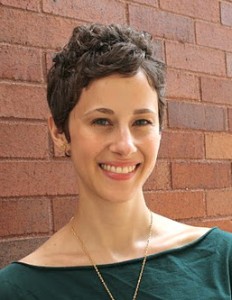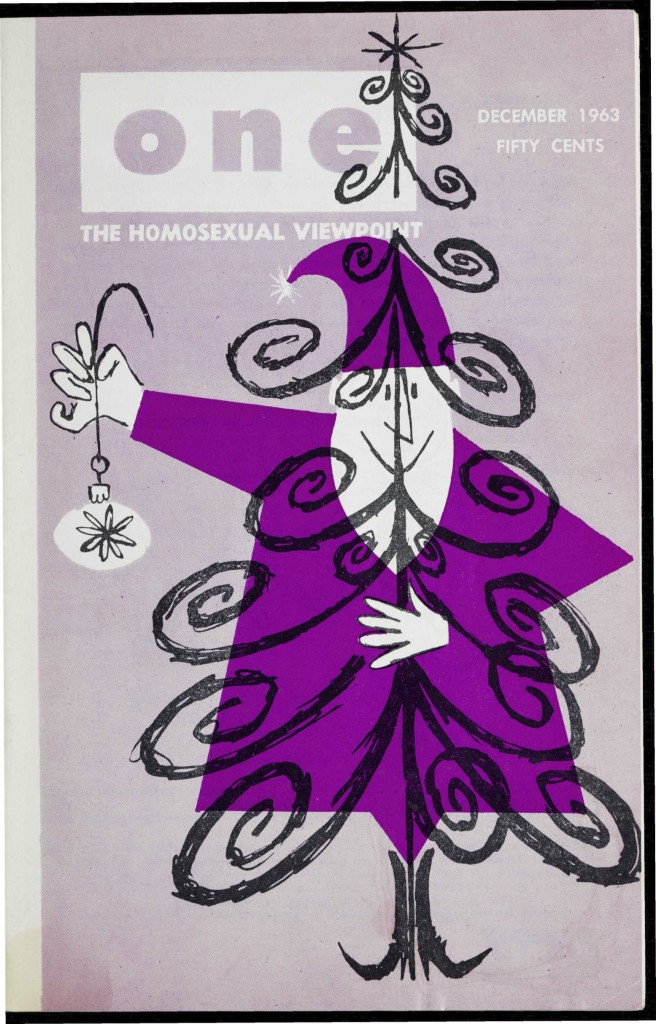For most of us, envisioning Christmas in postwar America brings to mind tinsel-covered trees, girls and boys in matching pajamas, dads in Santa Claus beards, images drawn from old family photographs or the likes of It’s a Wonderful Life. Absent from these familial and familiar cultural memories are depictions of isolation, heartbreak, and alcoholism that were part and parcel of queer representations of Christmas at midcentury. Reading through the Christmas-themed stories and essays that appeared in the publications of the earliest American gay rights groups offers a different perspective, one of suffering. The holiday issues of The Mattachine Review, The Ladder, and ONE reveal the Christmas experience of those stuck outside the quintessential white, middle-class, nuclear family. With few exceptions, these newsletters and magazines showed Christmas to be a time of struggle for queers who had been pushed out of their biological families, abandoned by their lovers, and stigmatized by their churches.
These publications have been a major resource for historians interested in the politics of the homophile movement, but they hold value for scholars concerned with the history of emotions as well. Homophile magazines helped not only to foment a political struggle, but also to fashion—in Raymond Williams’ terms—a queer structure of feeling, that is, a shared perspective on and experience of the world that challenged the views taken as common sense. With respect to the holiday season, these publications suggest the extent to which depression constituted a queer Christmas tradition. I don’t mean to suggest that these magazines held up a mirror to gays’ and lesbians’ lives on Christmas, which were surely too diverse to be encapsulated in a handful of short stories and essays. Rather, taken as a whole they reflect an attempt to convey the particular ways Christmas felt different for queers, thus tying together, however tenuously, gays and lesbians as a distinct and oppressed minority group.
Frank Golovitz’s “The Lonely Season,” which appeared in ONE in 1957 serves as an apt example here. “I would guess that for at least half the homosexuals in our society,” Golovitz wrote, “Christmas is the loneliest time of year.” In his essay, Golovitz painted a group portrait of several stereotypical gay and lesbian characters united in their common struggle to get through the holidays. There’s the seventeen-year-old dyke who, rejected by the woman she loves and unable to return to the family she left behind, spends Christmas stuck in a shabby Miami hotel room. There’s the old queen who disguises his holiday unhappiness with alcohol, camp humor, and hollow assertions that Christmas “is just another day.” There’s the middle-aged, long-coupled lesbian whose plaintive lament, “Why can’t I have a baby like anyone else!” silences her cozy Greenwich Village holiday party. “Why are we trying to act so happy and normal? Christmas isn’t for queers,” she explodes, “It’s for normal, married people, respectable, wholesome people.”
In their utter pathos, many of these pieces attempted to reframe gays’ and lesbians’ holiday blues, to suggest that there was some nobility, some Christ-like virtue in their sadness and suffering. “With each holiday that comes and goes I die a little,” remarks a lesbian character in The Ladder whose lover has turned catatonic after accidentally killing an old man in a car accident. Her yearly ritual of decorating the Christmas tree she and her now-institutionalized lover once shared, on the holiday that brought them together, serves as a potent symbol of her ongoing commitment to their love. Another Ladder piece depicts a Christmas Eve encounter between an unmarried lesbian and her former lover, now unhappily married with a husband and three children. “Without Christmas lights, without the sounds of children I’d feel lost and lonely in the void,” the married woman confesses. Her ex-lover, on the other hand, more bravely and honestly faces Christmas alone without the security that comes with conformity. “The only thing I want to have is the freedom to be myself,” she declares.
As many scholars have pointed out, with the emergence of gay liberation such expressions of sadness and loss faded from view, replaced, at least publicly, with more politically “useful” feelings of righteous anger and pride. But the queer holiday blues have persisted, and they have even been a source of theorizing about sexuality. Eve Kosofsky Sedgwick wrote in Tendencies, “The depressing thing about the Christmas season—isn’t it?—is that it’s the time when all the institutions are speaking with one voice…They all—religion, state, capital, ideology, domesticity, the discourses of power and legitimacy—line up with each other so neatly once a year.” During the holidays “Christmas” and “the family” become one and the same; they are constituted in and through each other. Writing from the margins as queer identified and as Jewish, Sedgwick held that the fascinating—and exciting—thing about sexuality is the extent to which individuals’ bodies, appearances, identities, experiences, and fantasies fail to align so easily. It is precisely this messiness, this inconsistency, Sedgwick argues, that the concept “queer” aims to bring into focus. In other words, Christmas is queerness’s opposite.
December 25, 2015, will mark the first Christmas in American history that gay marriage is legal nation-wide. This year gays and lesbians have come closer than ever before to becoming those “normal, married people” Christmas so clearly signifies. So will the legalization of gay marriage bring the end of the queer Christmas blues? Do we want it to? According to Heather Love, “backward feelings” like those Christmas has engendered can help inspire social critique, demonstrate historical continuities, and “show up the inadequacies of queer narratives of progress.” Surely, for many, Christmas will bring the challenges it always has: strained extended family relationships, memories of love gone sour, and feelings of alienation from Christianity. As Golovitz wrote, at Christmas the word “gay” “seems an ironic and cruel misnomer for homosexuals.” But perhaps this year, with the legal recognition of our relationships some of the particular queerness of gays’ and lesbians’ Christmas depression will have dissipated. As some of the fragile feelings that have connected us evaporate, perhaps this year our holiday blues will look just like everyone else’s.
 Lauren Gutterman is an Assistant Professor in the American Studies Department at the University of Texas at Austin. She holds a PhD in History from New York University and recently completed a postdoctoral fellowship in the Society of Fellows at the University of Michigan. She is currently revising a book manuscript, Her Neighbor’s Wife: A History of Lesbian Desire within Marriage, which examines the personal experiences and public representation of wives who desired women in the United States since 1945.
Lauren Gutterman is an Assistant Professor in the American Studies Department at the University of Texas at Austin. She holds a PhD in History from New York University and recently completed a postdoctoral fellowship in the Society of Fellows at the University of Michigan. She is currently revising a book manuscript, Her Neighbor’s Wife: A History of Lesbian Desire within Marriage, which examines the personal experiences and public representation of wives who desired women in the United States since 1945.

NOTCHES: (re)marks on the history of sexuality is licensed under a Creative Commons Attribution-NonCommercial-NoDerivatives 4.0 International License.
Based on a work at www.notchesblog.com.
For permission to publish any NOTCHES post in whole or in part please contact the editors at NotchesBlog@gmail.com






I can’t wait for “Her Neighbor’s Wife: A History of Lesbian Desire within Marriage,” to come out. It takes a measure of bravery and dedication to fatherhood to allow your wife to follow her heart. In my case it’s worked out better for my son, but his life is going to be great and for me it’s boiled down to a minor inconvenience after 8 years.
Really enjoyed this post. Reminds me a bit of the arguments Warner made in _The Trouble With Normal_ years ago.
Will also be really excited to read the book the author currently has in progress!
Thanks for raising this seasonal issue! The problem for queers at Christmas in nothing new nor peculiarly American. Magnus Hirschfeld wrote about the same kind of problems in 1905 in Berlin. A translation of some of his writing on this theme is introduced to us by Colin Wilson and can be found at rs21.org.uk/2015/12/13a-homosexual-christmas-in-1905-berlin/
For quite some time now, I’ve had the idea that we gays are the ones who are really “normal” and the hets are the ones who are “queer.” That is, they need to come over to us, not the other way around. They need to see that the way we are, our “otherness,” is what is really human. They are living in a fantasy world and it isn’t working. I really like what Eve Sedgwick says about things “not lining up” in us–but I think that is way more true for the hets than they ever want to face and that is why so many of them are afraid of us. They don’t want to admit the truth, that they are freaks, too. So they take a false comfort in seeing themselves as “straight” or aligned.